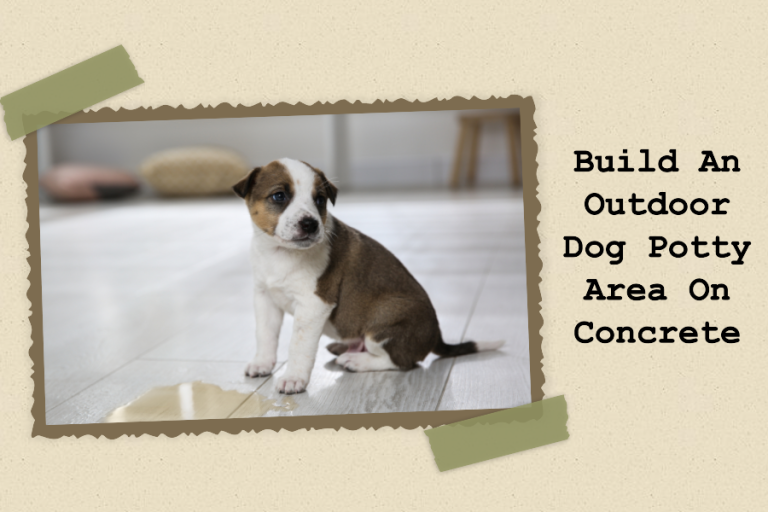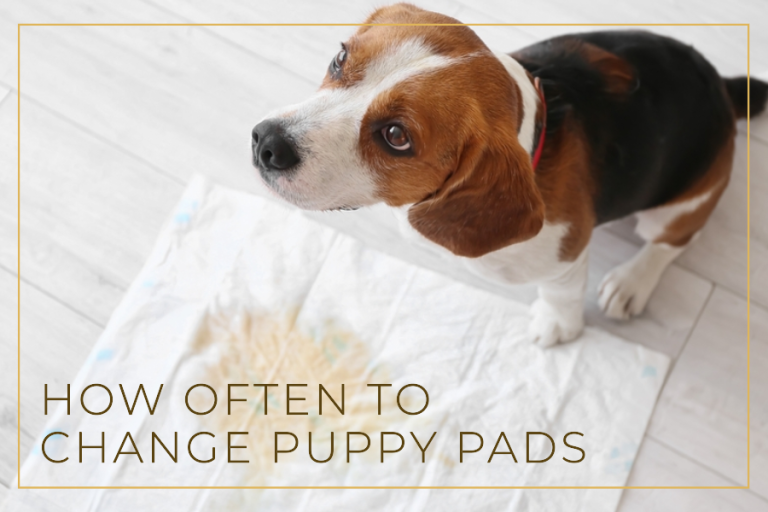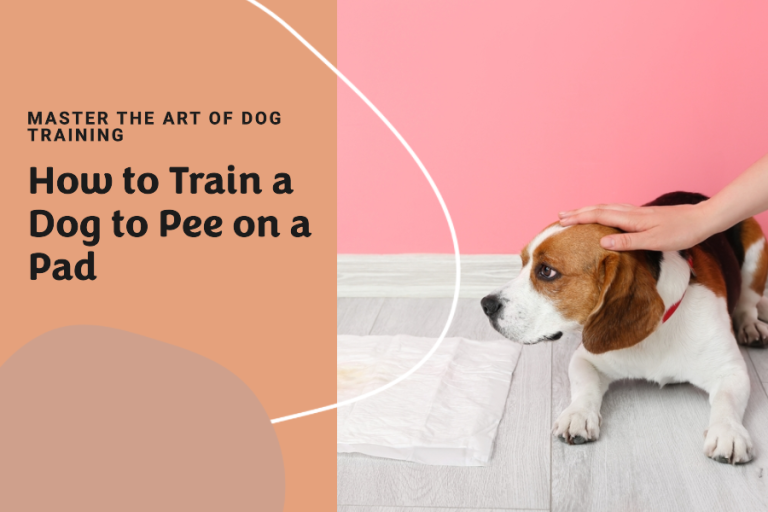What Angle Do You Cut Dog Nails At? Best Practices and Tips
Have you ever watched a professional groomer wield their clippers around a dog’s nails smoothly and mess-free. Trimming your dog’s nails is not just about keeping your floors scratch-free. Getting it wrong can mean discomfort or even pain for your furry friend. The question of “What angle do you cut dog nails at?” is a puzzle for many pet owners.
In this article, we will discuss our dog’s nail care. Discover the mystery of the right angle for cutting our furry friends’ nails. It’s not just about looks; it’s about their comfort and health too. In this blog, we’ll share the ins and outs of dog nail trimming, why the angle matters, and what the experts say. Ready to dig in? Let’s go!
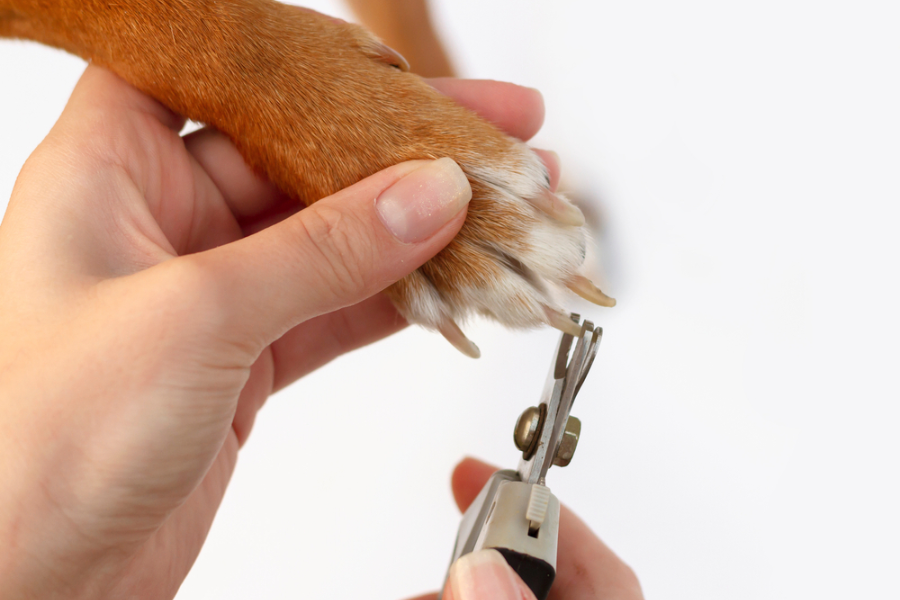
What Angle Do You Cut Dog Nails At?
When it comes to dog grooming, nail care holds a paramount place. The proper trimming of your furry friend’s nails can vastly improve their comfort and overall well-being.
However, a common question that we often encounter from pet owners is, “What angle do you cut dog nails at?”.
The Correct Angle for Trimming Dog Nails
Now, let’s delve into the core topic – the correct angle for trimming dog nails. A dog’s nail is not like a human nail. It has a hard outer shell and a soft cuticle in the center, known as the ‘quick‘. The quick is sensitive and can cause bleeding and pain if cut. Therefore, it’s crucial to trim the nails at the right angle to avoid the quick.
Typically, experts recommend cutting a dog’s nails at a 45-degree angle. This angle is considered ideal as it allows for a safe distance from the quick, reducing the risk of accidentally cutting into it.
Why This Specific Angle?
The 45-degree angle is suggested by experts because it aligns with the natural curvature of a dog’s nail, allowing for a smooth and safe cut. Cutting at this angle also helps to maintain the nail’s structural integrity and prevent splintering, which could potentially harm your dog.
Therefore, adhering to this specific angle is a significant step in ensuring your dog’s comfort and health during the nail trimming process.
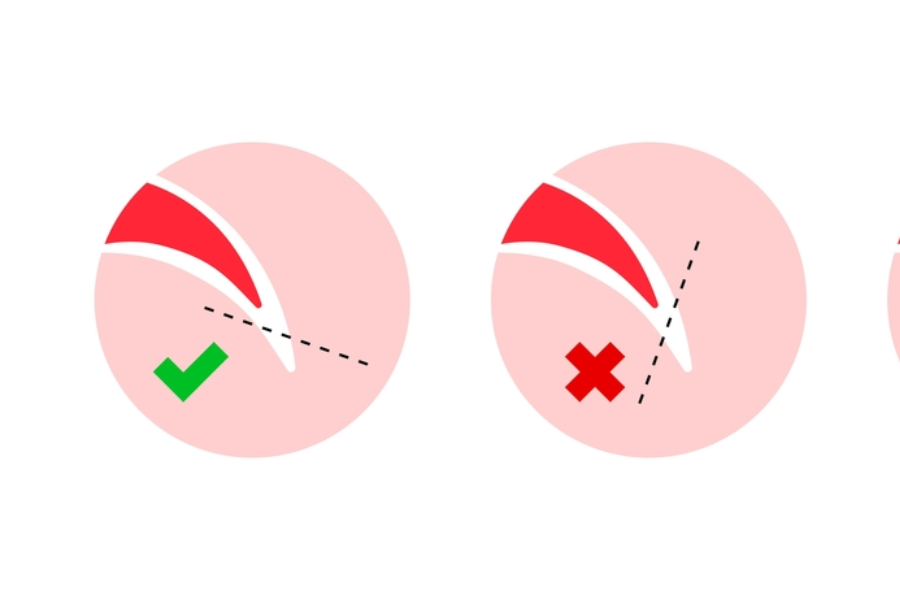
The Angle in Different Dog Breeds
Did you know that the breed of your dog can significantly influence the angle at which you should trim their nails?
Before we explore the angles, it’s important to understand that a dog’s breed dictates many physical attributes, including paw shape and nail structure.
Breed-Specific Nail Thickness:
The thickness of a dog’s nails can vary significantly across different breeds, and understanding these differences is essential when it comes to grooming and nail care.
- Nails of small breeds like poodles, chihuahuas, and poms tend to be finer and more delicate than those on larger dogs.
- Large and giant breeds, such as Great Danes, Mastiffs, and Saint Bernards, typically have thicker and stronger nails that can withstand more force.
The Ideal Angle
For most dogs, a 45-degree angle is recommended, but this generic advice doesn’t cater to the diversity of dog nails.
- Active Breeds: Dogs that are active, like Border Collies or Labradors, naturally wear down their nails. For these breeds, less frequent trimming might be needed, and the angle might be more forgiving.
- Large Breeds: Large breeds require a confident hand and a trimmer that can handle thick nails. The angle may need to be adjusted to be slightly less than 45 degrees to account for the size and curvature of the nail.
- Lapdogs: Small breeds that spend most of their time indoors, like Yorkies or Bichons, often need a more acute angle and a gentle touch to prevent over-cutting.
Your dog’s health and appearance will benefit from your practice of finding the ideal angle for their breed. The American Kennel Club suggests that nails should be trimmed every 3–4 weeks, but this varies by breed and activity level. Remember, patience and practice make perfect.
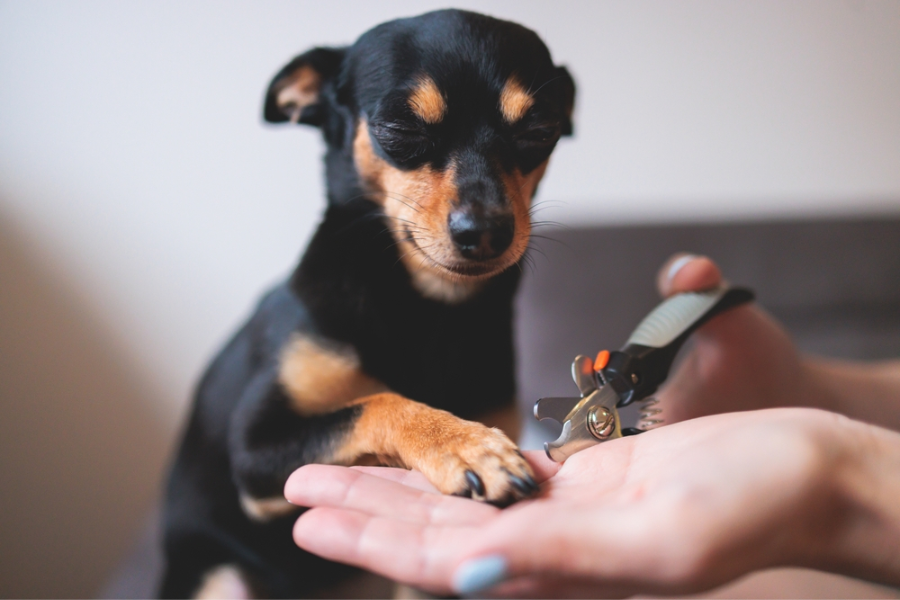
How to Cut Dog Nails Safely
The process of trimming your dog’s nails can seem problematic, but with the right approach and tools, it becomes an easy task. Here’s our step-by-step guide on how to do it safely.
Step-by-Step Guide on Safely Trimming a Dog’s Nails
Firstly, ensure your dog is calm and comfortable. You may want to pet them or give them a treat before beginning.
Next, hold your dog’s paw firmly but gently, to avoid causing any discomfort. Choose a nail to begin with, ideally starting with the front paws as they are easier to reach. Position the nail clippers at a 45-degree angle towards the tip of the nail, ensuring you’re cutting from top to bottom, not side to side.
Make a swift, confident cut across the nail. Be careful not to cut too far into the nail to avoid reaching the quick, sensitive part of the nail that contains blood vessels and nerves.
If you’re uncertain, make several small clips instead of one large one. After cutting, use a nail file to smooth any sharp edges. Repeat this process on each nail, remembering to reward your dog throughout to make the experience positive for them.
Practical Tips for the Nail Cutting Process
- Patience is essential during the nail trimming process; avoid hurrying to prevent causing stress for your dog.
- Reward your dog with treats or praise after trimming each nail to associate the experience positively.
- If your dog exhibits signs of stress or fear, take breaks between trimming each paw to keep them calm.
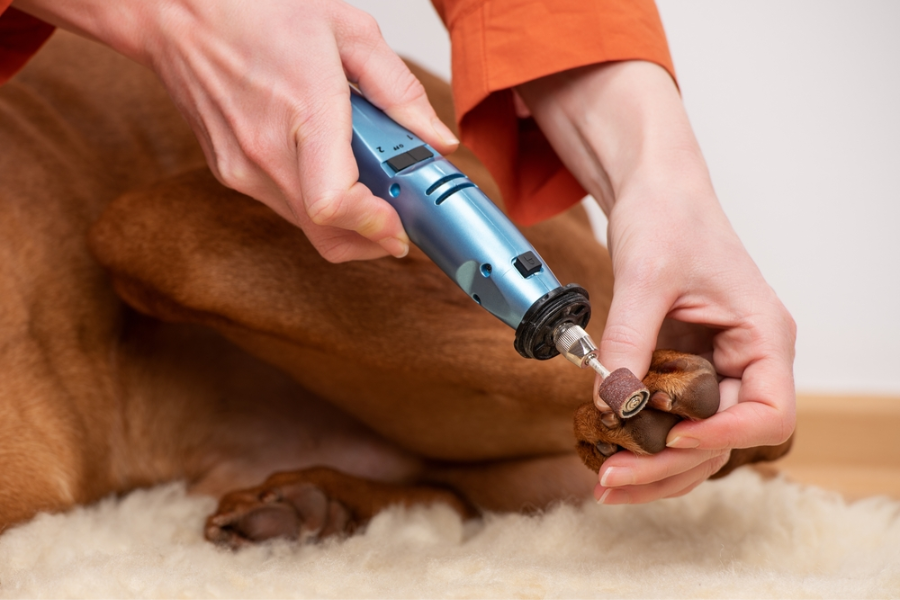
Is It Better to Cut or Grind Dog Nails?
Both cutting and grinding have their own sets of advantages. Cutting is quick and efficient, but it can lead to sharp edges and has a higher risk of cutting into the quick.
On the other hand, grinding, although a slower process, allows for a smoother finish and more control over the length of the nail.
The choice between cutting or grinding ultimately depends on your dog’s comfort and your own confidence in the process.
| Aspect | Cutting | Grinding |
| Precision | High – can be very precise with practice | Moderate – less precise than cutting |
| Noise Level | Low – quiet clipping sound | Higher – buzzing sound may scare some dogs |
| Risk of Cutting Quick | Higher – especially if the quick is not clearly visible | Lower – gradual removal reduces risk |
| Smoothness of Finish | Can leave sharp edges; may require filing | Leaves a smooth finish |
| Time Consumption | Quick – if done correctly and confidently | Takes longer than cutting, but is generally more gradual and controlled |
Do You Cut Dogs Nails Vertically or Horizontally?
The best way to cut a dog’s nails is at a 45-degree angle from top to bottom. This method, often described as a diagonal cut, combines the benefits of both vertical and horizontal cutting. It reduces the chances of splitting the nail and avoids the quick more effectively than a straight vertical or horizontal cut.
How Often Should Dogs Nails Be Trimmed?
We believe it’s best to trim your dog’s nails about once a month. But remember, this isn’t a one-size-fits-all rule. Several things can change how often your dog needs a trim.
What Changes Nail Trimming Times?
Dogs that walk a lot on hard ground, like concrete, may grind down their nails naturally. They won’t need trims as often. But dogs that stay mostly indoors or walk on soft grass may need more trims.
Some dog breeds have nails that grow faster than others. Older or less active dogs might need more trims too. Always keep an eye on your dog’s nails to know when it’s time for a trim.
How Does Your Dog’s Lifestyle Affect Nail Growth?
If your dog is active and often walks on hard ground, their nails will stay short naturally. They won’t need to see the nail clippers as often! But if your dog is a homebody or spends lots of time on soft surfaces, you’ll need to trim their nails more often.
Always check your dog’s nails. If they’re clicking on the floor or your dog seems uncomfortable walking, it’s time for a trim. If your dog’s nails stay short and don’t bother them, you can wait longer between trims.
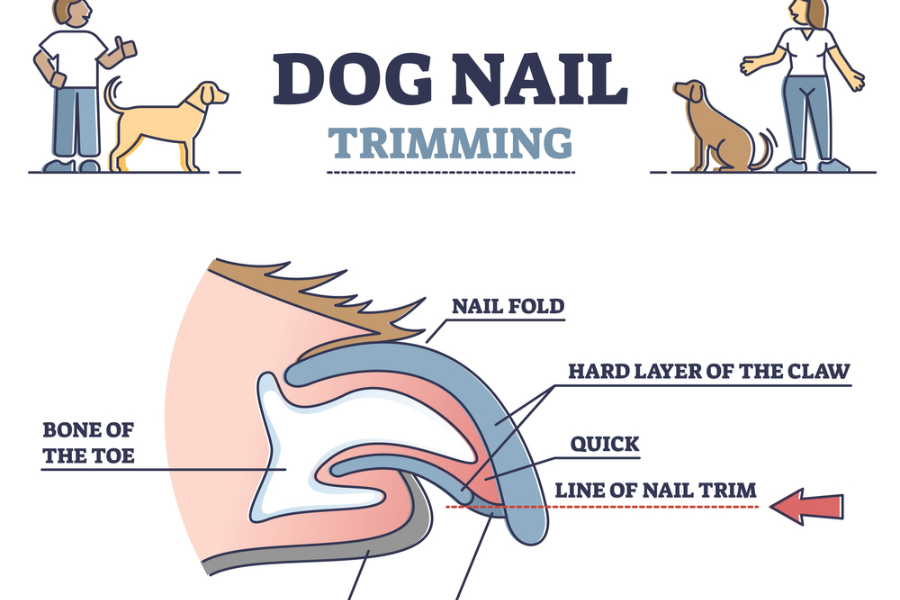
What to Do If You Cut a Dog’s Nail Too Short
While trimming your dog’s nails, one common mistake we often encounter is cutting the nail too short. It’s a common concern for many pet owners, but don’t worry, we’re here to guide you through it.
First aid for dogs with short nails.
Firstly, don’t panic. If you cut your dog’s nail too short, causing it to bleed, quickly apply a styptic powder or pencil, which helps to clot the blood. Apply pressure to the area with a clean cloth and give your dog some time to calm down. If bleeding continues for more than a few minutes, consult your vet immediately.
Preventive measures for dog owners to avoid making this common mistake.
Avoiding cutting your dog’s nails too short involves understanding your dog’s nail structure. To prevent this, always cut at a 45-degree angle, and make small cuts to avoid reaching the quick.
Using a light source from behind can help you see the quick more clearly in darker nails. Regularly trimming your dog’s nails also helps the quick to recede, making the process easier over time.
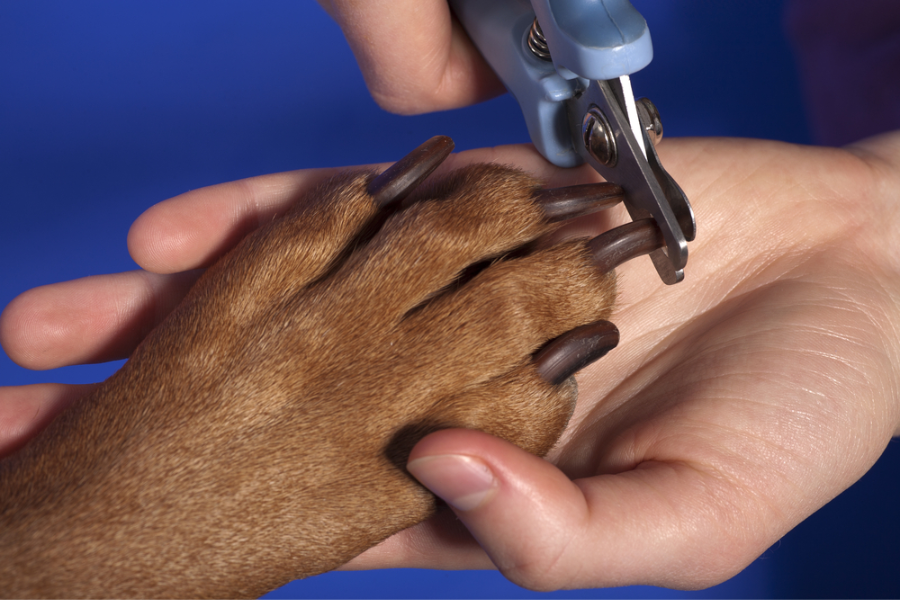
Are Dogs Nails Easier to Cut Wet?
This is a common question amongst dog owners, and we’ve delved into the research to provide a clear answer.
Some believe that wet nails are easier to trim since they are softer. However, this is a myth. Wet nails can be slippery and more difficult to handle, increasing the chances of making a mistake. Experts agree that dry nails are the optimal condition for trimming as they provide a clean, sharp cut.
Remember, nail trimming should not be a stressful experience for you or your dog. With the right knowledge, tools, and approach, it can be a simple part of your dog’s grooming routine. And as always, if you’re unsure or uncomfortable, seek professional help.
Conclusion
So, we’ve shared a lot about dog nail care. We’ve looked at why the right nail trim angle matters for your dog’s comfort and health. We’ve also shown you how to safely trim your dog’s nails, and shared tips to make it easier on you and your dog.
We’ve talked about how often to trim your dog’s nails and what can change that. We’ve also given you tips on what to do if a nail gets cut too short, and how to avoid that happening.
As we wrap up, we hope you’ve found our guide useful. Remember, taking care of your dog’s nails is a big part of keeping them happy and healthy. So, keep those nails trimmed right, and your furry friend will thank you!







